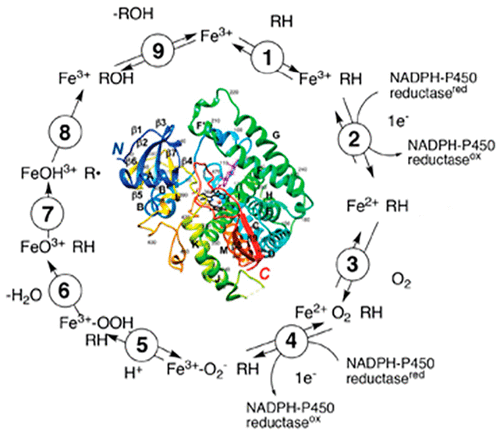当前位置:
X-MOL 学术
›
ACS Catal.
›
论文详情
Our official English website, www.x-mol.net, welcomes your
feedback! (Note: you will need to create a separate account there.)
Mechanisms of Cytochrome P450-Catalyzed Oxidations
ACS Catalysis ( IF 11.3 ) Pub Date : 2018-10-18 00:00:00 , DOI: 10.1021/acscatal.8b03401 F. Peter Guengerich 1
ACS Catalysis ( IF 11.3 ) Pub Date : 2018-10-18 00:00:00 , DOI: 10.1021/acscatal.8b03401 F. Peter Guengerich 1
Affiliation

|
Enzymes are complex biological catalysts and are critical to life. Most oxidations of chemicals are catalyzed by cytochrome P450 (P450, CYP) enzymes, which generally utilize mixed-function oxidase stoichiometry, utilizing pyridine nucleotides as electron donors: NAD(P)H + O2 + R → NAD(P)+ + RO + H2O (where R is a carbon substrate and RO is an oxidized product). The catalysis of oxidations is largely understood in the context of the heme iron–oxygen complex generally termed Compound I, formally FeO3+, whose basis was in peroxidase chemistry. Many X-ray crystal structures of P450s are now available (≥822 structures from ≥146 different P450s) and have helped in understanding catalytic specificity. In addition to hydroxylations, P450s catalyze more complex oxidations, including C–C bond formation and cleavage. Enzymes derived from P450s by directed evolution can even catalyze more unusual reactions, e.g., cyclopropanation. Current P450 questions under investigation include the potential role of the intermediate Compound 0 (formally FeIII–O2–) in catalysis of some reactions, the roles of high- and low-spin forms of Compound I, the mechanism of desaturation, the roles of open and closed structures of P450s in catalysis, the extent of processivity in multistep oxidations, and the role of the accessory protein cytochrome b5. More global questions include exactly how structure drives function, prediction of catalysis, and roles of multiple protein conformations.
中文翻译:

细胞色素P450催化氧化的机理
酶是复杂的生物催化剂,对生命至关重要。化学药品的大多数氧化反应都由细胞色素P450(P450,CYP)酶催化,该酶通常利用混合功能氧化酶化学计量法,利用吡啶核苷酸作为电子供体:NAD(P)H + O 2 + R→NAD(P)+ + RO + H 2 O(其中R为碳底物,RO为氧化产物)。在血红素铁-氧络合物(通常称为化合物I,正式为FeO 3+,其基础是过氧化物酶化学。现在可以使用P450的许多X射线晶体结构(来自≥146种不同的P450的822种结构),并且有助于理解催化特异性。除羟基化作用外,P450还能催化更复杂的氧化反应,包括C–C键的形成和裂解。通过定向进化衍生自P450的酶甚至可以催化更多不寻常的反应,例如环丙烷化。目前正在研究的P450问题包括中间体化合物0(以前是Fe III –O 2 –)在某些反应的催化中,化合物I的高和低旋形式的作用,去饱和的机理,P450的开闭结构在催化中的作用,多步氧化过程中的合成性程度以及辅助蛋白细胞色素b 5。更多的全球性问题包括结构如何驱动功能,催化的预测以及多种蛋白质构象的作用。
更新日期:2018-10-18
中文翻译:

细胞色素P450催化氧化的机理
酶是复杂的生物催化剂,对生命至关重要。化学药品的大多数氧化反应都由细胞色素P450(P450,CYP)酶催化,该酶通常利用混合功能氧化酶化学计量法,利用吡啶核苷酸作为电子供体:NAD(P)H + O 2 + R→NAD(P)+ + RO + H 2 O(其中R为碳底物,RO为氧化产物)。在血红素铁-氧络合物(通常称为化合物I,正式为FeO 3+,其基础是过氧化物酶化学。现在可以使用P450的许多X射线晶体结构(来自≥146种不同的P450的822种结构),并且有助于理解催化特异性。除羟基化作用外,P450还能催化更复杂的氧化反应,包括C–C键的形成和裂解。通过定向进化衍生自P450的酶甚至可以催化更多不寻常的反应,例如环丙烷化。目前正在研究的P450问题包括中间体化合物0(以前是Fe III –O 2 –)在某些反应的催化中,化合物I的高和低旋形式的作用,去饱和的机理,P450的开闭结构在催化中的作用,多步氧化过程中的合成性程度以及辅助蛋白细胞色素b 5。更多的全球性问题包括结构如何驱动功能,催化的预测以及多种蛋白质构象的作用。































 京公网安备 11010802027423号
京公网安备 11010802027423号